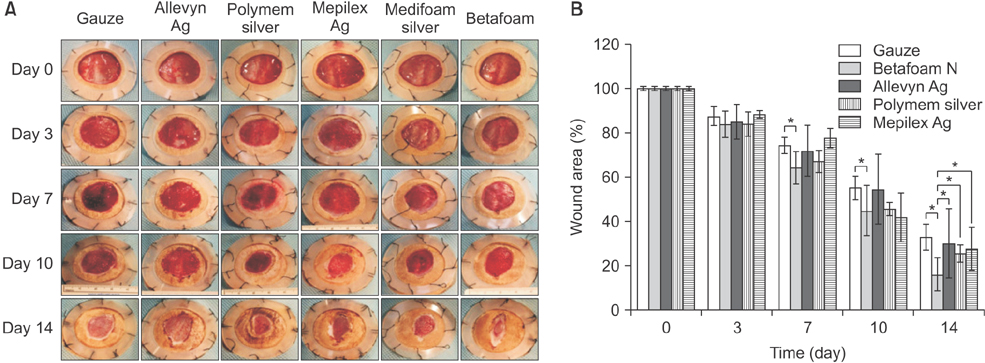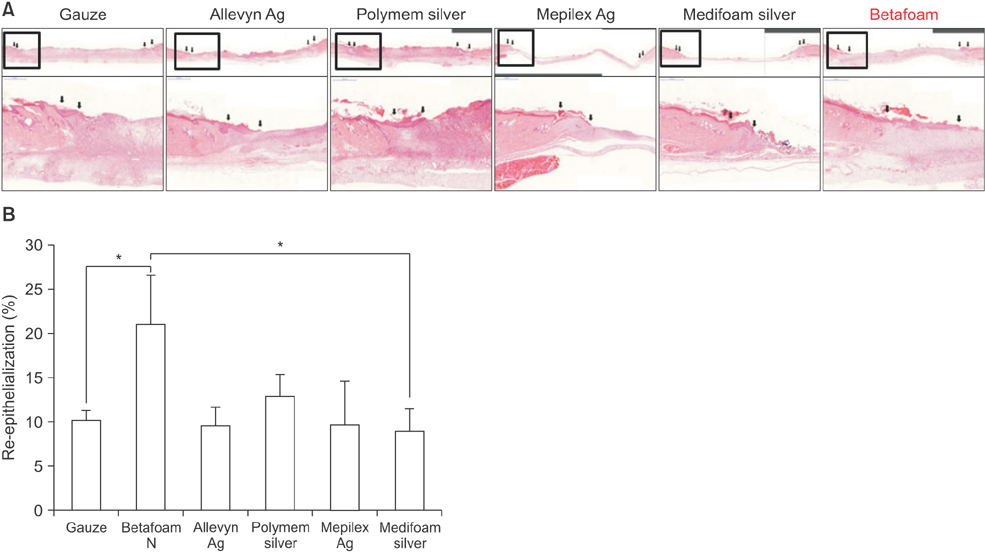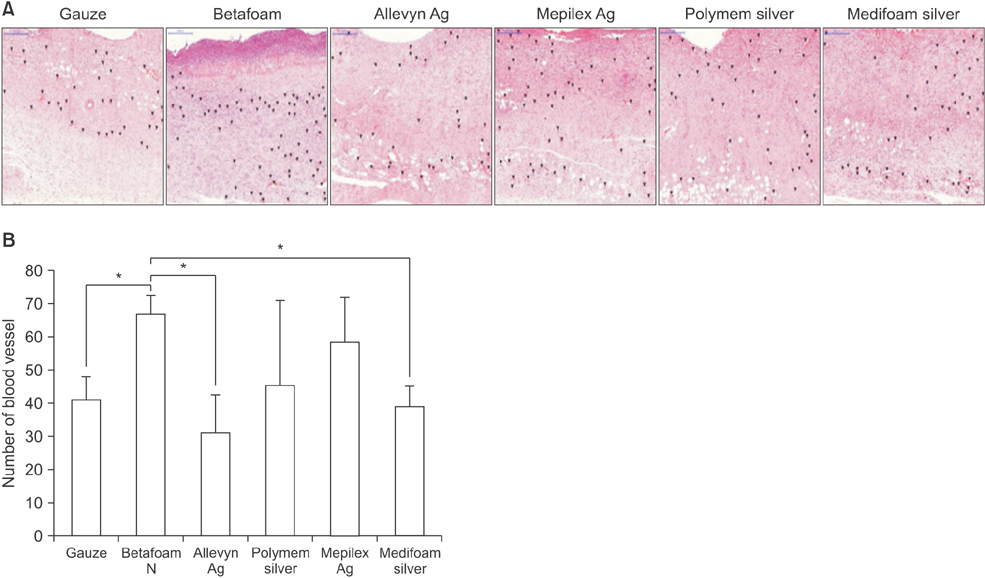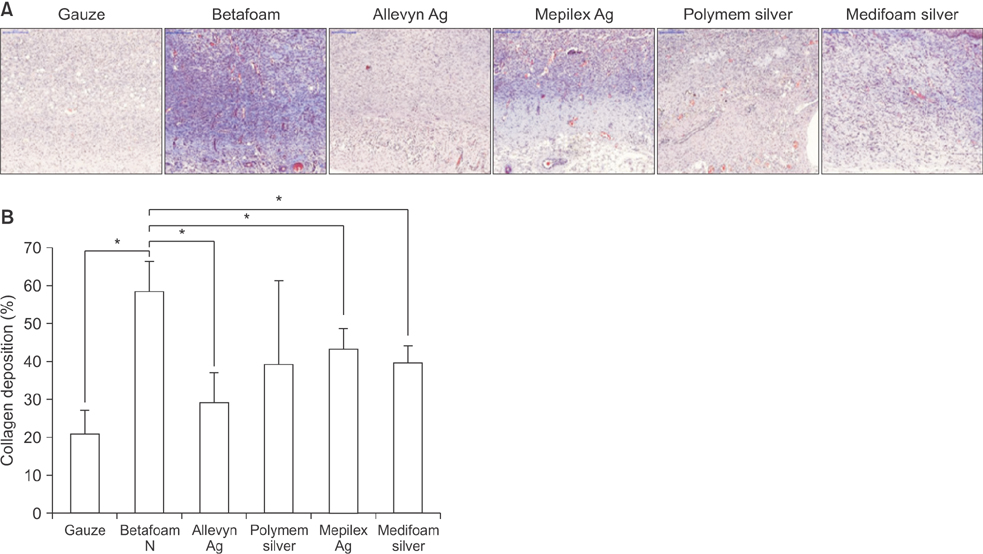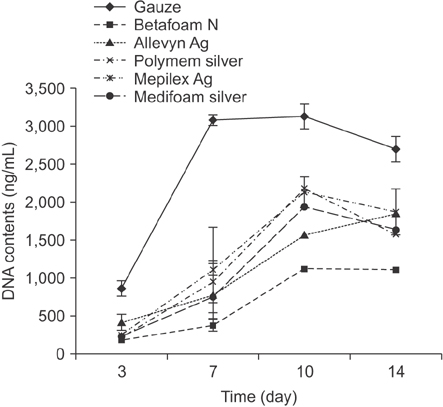Ann Surg Treat Res.
2018 Jan;94(1):1-7. 10.4174/astr.2018.94.1.1.
Evaluation of a polyurethane foam dressing impregnated with 3% povidone-iodine (Betafoam) in a rat wound model
- Affiliations
-
- 1Department of Surgery, Hallym University Chuncheon Sacred Heart Hospital, Hallym University College of Medicine, Chuncheon, Korea.
- 2Department of Surgery, Uijeongbu St. Mary's Hospital, College of Medicine, The Catholic University of Korea, Uijeongbu, Korea. skys9615@gmail.com
- KMID: 2405332
- DOI: http://doi.org/10.4174/astr.2018.94.1.1
Abstract
- PURPOSE
The purpose of this study was to evaluate the efficacy of Betafoam in terms of wound healing and safety.
METHODS
Fifty-four male adult Sprague-Dawley rats (weight, 200-250 g) were used in the study. Full-thickness skin defects were created on the back of each rats. The rats were assigned to 6 groups according to the type of wound dressing used (n = 9 for each group): Betafoam, Allevyn-Ag, Mepilex-Ag, Medifoam silver, Polymem-Ag, and gauze. The wound size, histological findings, and amount of DNA on the changed dressings for each group were analyzed and compared.
RESULTS
All groups showed an effective decrease in wound size. However, the differences between Betafoam and the other dressings were statistically significant on day 14 (P < 0.05). The number of newly generated blood vessels in the Betafoam group was significantly higher than in the gauze, Allevyn-Ag, and Medifoam silver groups (P < 0.001). In the Betafoam group, the proportion of collagen deposition was highest and showed a significantly superior arrangement of collagen fibers compared with the gauze, Allevyn-Ag, Mepilex-Ag, and Medifoam silver groups. The total content of the remaining DNA counts of the exchanged dressings were significantly lower in the Betafoam group than the others.
CONCLUSION
Betafoam is effective in wound healing and provides the best performance amongst the various types of dressing materials in terms of re-epithelialization, angiogenesis, collagen deposition, and tissue invasion.
Keyword
MeSH Terms
Figure
Cited by 1 articles
-
Methods used in the study, Evaluation of a polyurethane foam dressing impregnated with 3% povidone-iodine (Betafoam) in a rat wound model, led to unreliable results
Linda LL Benskin
Ann Surg Treat Res. 2018;95(4):230-232. doi: 10.4174/astr.2018.95.4.230.
Reference
-
1. Yuksel EB, Yıldırım AM, Bal A, Kuloglu T. The effect of different topical agents (silver sulfadiazine, povidone-iodine, and sodium chloride 0.9%) on burn injuries in rats. Plast Surg Int. 2014; 2014:907082.2. Prestes MA, Ribas CA, Ribas Filho JM, Moreira LB, Boldt AB, Brustolin EV, et al. Wound healing using ionic silver dressing and nanocrystalline silver dressing in rats. Acta Cir Bras. 2012; 27:761–767.3. Lin YH, Lin JH, Wang SH, Ko TH, Tseng GC. Evaluation of silver-containing activated carbon fiber for wound healing study: In vitro and in vivo. J Biomed Mater Res B Appl Biomater. 2012; 100:2288–2296.4. Abdelrahman T, Newton H. Wound dressings: principles and practice. Surgery (Oxford). 2011; 29:491–495.
Article5. Lee JH, Ja Kwak J, Shin HB, Jung HW, Lee YK, Yeo ED, et al. Comparative efficacy of silver-containing dressing materials for treating MRSA-infected wounds in rats with streptozotocin-induced diabetes. Wounds. 2013; 25:345–354.6. Ge TC, Xing N, Chen J, Zhou JJ, Su GL, Shi JW, et al. Comparison among several foam dressings in the properties of water-absorption, water-locking and air permeability. Zhonghua Shao Shang Za Zhi. 2012; 28:349–352.7. Ziegler K, Gorl R, Effing J, Ellermann J, Mappes M, Otten S, et al. Reduced cellular toxicity of a new silver-containing antimicrobial dressing and clinical performance in non-healing wounds. Skin Pharmacol Physiol. 2006; 19:140–146.
Article8. Kramer SA. Effect of povidone-iodine on wound healing: a review. J Vasc Nurs. 1999; 17:17–23.
Article9. Losi P, Briganti E, Costa M, Sanguinetti E, Soldani G. Silicone-coated non-woven polyester dressing enhances reepithelialisation in a sheep model of dermal wounds. J Mater Sci Mater Med. 2012; 23:2235–2243.
Article10. Zou SB, Yoon WY, Han SK, Jeong SH, Cui ZJ, Kim WK. Cytotoxicity of silver dressings on diabetic fibroblasts. Int Wound J. 2013; 10:306–312.
Article11. Percival SL, Bowler PG, Russell D. Bacterial resistance to silver in wound care. J Hosp Infect. 2005; 60:1–7.
Article12. Kashyap A, Beezhold D, Wiseman J, Beck WC. Effect of povidone iodine dermatologic ointment on wound healing. Am Surg. 1995; 61:486–491.13. Bennett LL, Rosenblum RS, Perlov C, Davidson JM, Barton RM, Nanney LB. An in vivo comparison of topical agents on wound repair. Plast Reconstr Surg. 2001; 108:675–687.
Article14. Levenson SM, Geever EF, Crowley LV, Oates JF 3rd, Berard CW, Rosen H. The healing of rat skin wounds. Ann Surg. 1965; 161:293–308.
Article
- Full Text Links
- Actions
-
Cited
- CITED
-
- Close
- Share
- Similar articles
-
- Methods used in the study, Evaluation of a polyurethane foam dressing impregnated with 3% povidone-iodine (Betafoam) in a rat wound model, led to unreliable results
- A Prospective, Randomized, Non-inferiority Trial to Compare the Efficacy of 3% Povidone-Iodine Foam Dressing and Silver Foam Dressing in the Treatment of Pressure Injuries
- Comparison of Satisfaction Levels between Conventional and Silicone-Adhesive Polyurethane Foam Materials in Patients with Skin Wounds
- Two Cases of Allergic Contact Dermatitis due to Povidone-iodine
- The Effect of Medifoam (Hydrophilic Polyurethane Foam) Dressing In Split Thickness Skin Graft Donor Site



